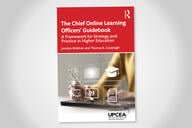You have /5 articles left.
Sign up for a free account or log in.
I first met Brandon Busteed when he was in a leadership role at Kaplan. In 2023, Brandon moved to the CEO role of BrandEd. Interested to learn more about BrandEd and wanting to hear Brandon’s thoughts on the growing entanglement of universities and companies in the teaching and learning space, I reached out to Brandon with some questions.
Q: Where does BrandEd fit in with the broader education and ed-tech ecosystem?
A: I joined BrandEd because I’ve never seen anything like it. We are delivering the world’s most engaging, industry-immersive educational programs—and that’s a compliment I gave to the organization before I joined it. Working in partnership with iconic global brands such as Sotheby’s, Vogue, Manchester City and The New York Times, we provide opportunities for students to delve deep into the art, fashion, sport and journalism industries; meet with experts who work in diverse roles across these industries; and gain real experience through hands-on projects and behind-the-scenes access.
I believe industry-immersive education will be one of the few truly scalable and valuable ways to meet the insatiable appetite that students have for improving their career readiness and outcomes. As a longtime champion of internships, I’ve come to the harsh realization that they simply do not scale. There were 8.2 million college students who wanted one this past year, while only 3.6 million got one and a mere 2.5 million had a quality internship experience.
At BrandEd, all of our programs are co-taught between industry experts and educational experts against the backdrop of some of the world’s most iconic organizations. We bring the best of both the work world and the education world together, and there is real magic at that intersection. I’m certain BrandEd will become one of the most important partners to high schools and colleges around the world who are looking to provide their students with more industry-immersive experiences.
(BrandEd operates Sotheby’s Institute of Art, Vogue College of Fashion, Manchester City Sports Business School and the School of The New York Times.)
Q: Among many educators at nonprofit universities, there is concern about the growing role that for-profit companies play in the higher education ecosystem. As someone with leadership roles at for-profit companies in the education space, how do you understand, interpret and address those concerns?
A: I wrote an article in Forbes this past year on this very subject. Although we tend to still make a big deal about the tax status of an organization, the reality is that such a distinction has blurred greatly. In my mind, the successful organization of the future will be a blend of the three sectors of our society—working to generate self-sustaining revenue (as a business would), contribute to a social good (as a nonprofit would) and engage itself in public policy (as a government entity would).
Today, the fastest-growing universities are nonprofit universities that have borrowed heavily from a for-profit playbook (think massive investments in marketing and online programs). The most expensive educational “products” in the world are offered by elite, nonprofit universities (nearing $100K per year degree programs). And I know plenty of for-profit education entities that are delivering some of the highest-quality and best student outcomes.
As just one BrandEd-related example of our investment in career services for students: According to NACE, the median ratio of students to career advisers at U.S. colleges and universities is 1,583 to one. At BrandEd, ours is less than 80 to one—roughly 20 times better than the national average. We have made a huge commitment to improving career trajectories and outcomes for students, and it’s reflected in data like these.
I’ve now had a career working for three family-owned companies. First, I was the executive director of education and workforce development at Gallup (family owned). Then, I was the global head of learn-work innovation at Kaplan (owned by Graham Holdings, a family-controlled company). And now at BrandEd, which is also a family-owned company. Family-owned organizations have the unique advantage of thinking especially long-term. They believe in legacy, in doing things right. And they have the patience to invest in the long run. I’ve never operated through quarterly earnings reports. Instead, these organizations think in decades-long terms. And that’s especially important if you’re going to build something of lasting quality for students.
Q: What advice do you have for early and midcareer professionals looking to ascend to leadership roles in companies working at the intersection of education and technology?
A: Nothing beats clearly understanding what students and educators need to be successful. Too many people get caught up in prominent—but often distracting—aspects of the ed-tech world: the technology or the finances/fundraising or the marketing of the organization.
Deeply understanding our most important constituents in the form of students and educators is central to ascending to leadership roles. But then beware of the pitfall once you’ve arrived in a leadership role—which is then spending too much of your time on various management responsibilities at the cost of remaining in tune with the needs of students and educators.




